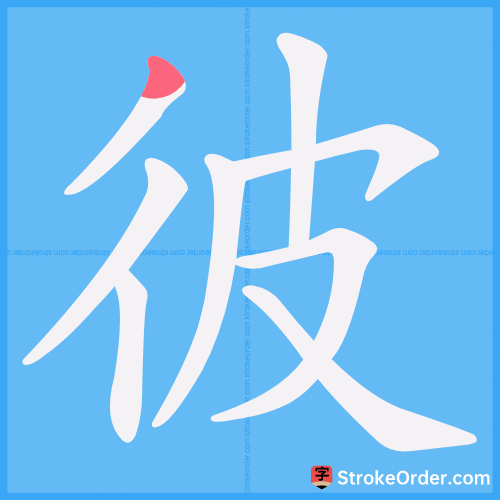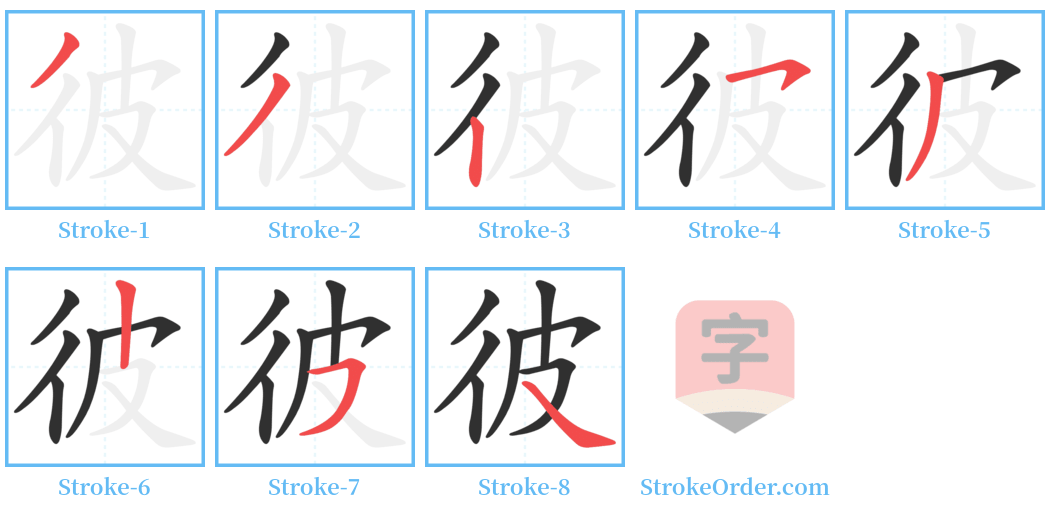彼 Stroke Order
Animated Stroke Order of 彼

Stroke Order Diagrams for 彼

Step-by-Step Handwriting Guide for 彼

Learn to Write Chinese Characters with Video Tutorials
Watch the video of writing the Chinese character "彼", learn the correct stroke order (笔顺) of the character "彼", and master the standard way of writing the character "彼".
Free Printable Handwriting Practice with Stroke Order: 彼
Printable Writing Practice Worksheet of "彼" in Portrait Orientation (Tian Zi Ge)

Printable Writing Practice Worksheet of "彼" in Landscape Orientation (Tian Zi Ge)

Information of 彼
Pinyin
bǐ
Radical
彳
Strokes
8 strokes
Usage
★★★★★
Definition
that / those / (one) another)
彼 [bǐ]
1. 那,那个:
(that)
- 彼岸 (the other shore).
- 此起彼伏 (one rises while the other falls).
2. 他,对方:
(he, the other party)
- 知己知彼 (know oneself and know the other).
- 彼此 (each other).
本义: 流行、传播,施加
(Original meaning: circulate, propagate, apply)
造字法: 形声。从彳,皮声。“彳”( chì).
(Formation: Phonetic-ideographic. From the component ‘彳’, pronounced ‘chì’.)
1. 那,与“此”相对 (that, opposed to 'this')
引:
1. 《玉篇》: 彼,对此称彼也。
(In Yu Pian: '彼' is called 'that' in relation to 'this'.)
2. 《诗·魏风·硕鼠》: 逝将去女,适彼乐土。
(In the Book of Songs: 'I will go, you shall reach that happy land.')
3. 《诗·魏风·伐檀》: 彼君子兮,不素食兮。
(In the Book of Songs: 'That gentleman does not eat plain food.')
4. 宋·沈括《梦溪笔谈》: 此土延续石耳。
(In Song Dynasty: 'This land extends to Stone Ear.')
例:
又如: 彼此腾倒着做 (each other exchange).
彼苍 (referring to the sky).
此起彼伏 (one rises while the other falls).
彼人 (that person).
2. 另一个事物 (the other; another)
引:
1. 《孙子·谋攻》: 知彼知己,百战不殆。
(In Sun Tzu: 'Know the other and know oneself, and in a hundred battles, you will not be in danger.')
例:
又如: 由此及彼 (from this to that).
3. 他,他们 (the other part)
引:
1. 唐·韩愈《师说》: 彼与彼年相若也。
(In Tang Dynasty: 'They are of comparable age.')
2. 唐·柳宗元《童区寄传》: 幸而杀彼,甚善!
(In Tang Dynasty: 'Fortunately, killing the other was very good!')
know yourself, know your enemy (idiom, from Sunzi's "The Art of War" 孫子兵法|孙子兵法[Sun1 zi3 Bing1 fa3])
lit. to attend to one thing and lose sight of another (idiom) / fig. to be unable to manage two or more things at once / cannot pay attention to one thing without neglecting the other
to make no distinction between what's one's own and what's another's (idiom) / to share everything / to be on very intimate terms
up here, down there (idiom); to rise and fall in succession / no sooner one subsides, the next arises / repeating continuously / occurring again and again (of applause, fires, waves, protests, conflicts, uprisings etc)
Input Method for 彼
Pinyin
bi3
Wubi
thcy|tby
Cangjie
hodhe
Zhengma
oixi
Four Corner
24247
Unicode
U+5f7c
Same Pronunciation Characters